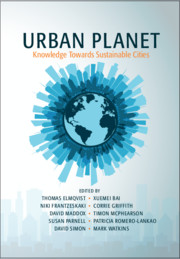In my view, Banksy, the British street artist from Bristol, is one of the most insightful urban commentators of our time. His prankster performance art talks to us about the way cities breathe and sweat and create and destroy. His artistic vision has unsettled both the art world and city hall alike, and challenged us to see ourselves and our cities as they are, not as we think they should be. His images do not sit easily in rarefied art galleries (even though he has been known to smuggle his works into museums such as the MoMA), but rather reach out and challenge us where we live, surprising us on street corners, telephone boxes, and campervans. The element of risk is central to Banksy’s art. In his words, “The greatest crimes in the world are not committed by people breaking the rules but by people following the rules” (Banksy Reference Banksy2005).
Perhaps intuitively following this guidance, I realized early on in my career as a biologist interested in cities that my science was best tested on the street rather than in a remote laboratory. As a result, over two decades ago, I traded in the ivory tower for city hall and now practice what I can only describe as “guerrilla street science.” As a scientist-in-practice, I have become a hybrid personality, operating at and across the boundaries of science, policy, and practice with no fixed institutional allegiances. Much like Banksy’s street art, this sort of street science is not politically correct or value neutral, and it is often viewed with suspicion and regarded as a political bad. It is seen as going where science should not go, challenging existing bases of power, and creating conflicting discourses. Its proponents are heavily criticized and interrogated: Can a good policy-maker really be a good scientist, or does science get in the way of good policy-making? By adopting this more fluid and uncertain identity, the scientist-in-practice becomes someone of whom all formal interest groups are wary; they can never be certain of which agenda those scientists-in-practice are advancing. Are we “bombing” – in graffiti terms “to bomb” is to paint many surfaces in an area – policy with science, or science with policy? Or ignoring both and simply getting the job done?
In this difficult environment, the risk-takers survive by finding others like themselves, building informal networks that are often more influential than formal reporting lines. Building trust and smart alliances within these subversive crews – a crew, krew, or cru is a group of associated writers or graffiti artists that often work together – helps create an ecology of revolutions that is more sustainable than just a single, winner-takes-all revolution. In this world, decision-making is more organic and processes more flexible, and the normative constraints of traditional science, policy, and practice do not normally apply. As a result, scientists-in-practice that can navigate the gray institutional spaces are generally better able to maneuver through complex institutional processes that might otherwise prove time-consuming and limit innovation. This suggests that the transgressive change required in the world’s cities might be best catalyzed in these informal, noninstitutionalized shadows, rather than in the formal institutional limelight. Street art and street science have more in common than one might think.
Working in this unchartered territory also means reprioritizing conceptual reference points: Developing an understanding that political ecology is as important as ecology; that perception is as powerful (if not more powerful) than fact; and that it isn’t what you know, but who you know. I have learned that good ideas have a limited political shelf life, even if they remain scientifically valid, creating an ongoing need to find new scientific motivations to justify the same actions. As a result, you will fight the same battles over and over again, often in different political cycles. Unfortunately, in the real world, science is not a silver bullet that removes the policy challenge with a single shot; it also does not tell you how to deal with the death threats linked to scientific decisions that frustrate unsustainable political or economic ambition!
The value of the informal networks of risk-takers and change-makers who work well beyond the reach of performance management plans and indicators cannot be overstated. They signal the diversity and complexity of skills required to drive real change and suggest the need to create a multiplicity of change agents, from research scientists to scientists-in-practice, rather than striving (rather unrealistically) for single individuals with a full range of transdisciplinary skills. How do we do this? My experiences suggest that the people with the capacity to harness the gray institutional spaces and to connect and challenge the formal systems benefit greatly from the creation of nexus points where the policy and scientific world engage on a regular basis. In the city I work in, we do this through research partnerships established with the local university that engages both the academic and local government officials. These interactions make the gaps and opportunities more legible to the institutional entrepreneurs in both environments. We also actively seek out people who are institutionally irreverent and encourage them to drive agendas of change by providing them with a community of support and ongoing opportunities to work on programs and projects capable of introducing new ideas and information into traditional systems. This creates a complex canvas for action on which we begin to sketch out multiple possible futures for our city.
As the challenges facing the world’s cities grow, we must find ways of putting an increasingly diverse range of conceptual and tactical spray cans into the hands of our scientists and policy-makers – this will often blur the lines between science, policy, and maybe even art!



